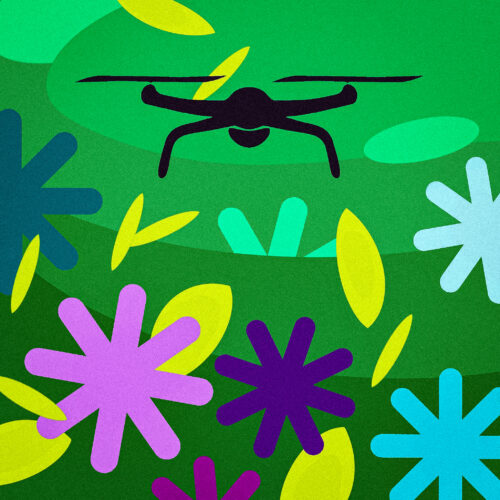Art by Sophia Zhao.
Flying over the cliffs of Kauai, a drone known as the Mamba sweeps the area on a rescue mission, searching for valuable buds of life beyond normal reach. On these cliffs lie extremely rare plants, many only found in Kauai, and some the last of their kind. The Hawaiian island is home to 250 endemic flora species found exclusively on the island, ninety-seven percent of which are classified as endangered or extinct. Environmental hazards are increasing the extinction rate to five hundred times the expected rate without human interference. For years, botanists have braved Kauai’s cliffs and other hard-to-access locations in search of these critically endangered plants. However, the areas are extremely hazardous and are time-consuming and expensive to access.
For years, drones have been a prominent tool in environmental conservation and monitoring in harsh environments, imaging across different wavelengths of light and identifying plant habitats and distributions. However, the development of drones to navigate and interact with dangerous and inaccessible environments is an entirely new innovation in this field. “What differentiates what we’re doing with drones is that we’re interacting directly with the environment,” said Hughes La Vigne, a PhD student of robotics engineering at the University of Sherbrooke and co-founder of Outreach Robotics. The company first took root following the creation of the DeLeaves sampling system, a device designed to collect branches from treetops and canopies. “The purpose of Outreach Robotics is to develop robotic tools that could help scientists working in conservation, reforestation, and other environmental purposes,” La Vigne said.
Enter the Mamba, the first aerial system that can sample plants on cliffs and transport them to a safer place. With a grant from National Geographic, Outreach Robotics teamed up with Ben Nyberg, a PhD student at the University of Copenhagen and the drone coordinator of the National Tropical Botanical Garden (NTBG), a nonprofit organization dedicated to the conservation and restoration of tropical plants. The project, which was published in Scientific Reports this fall, spanned two years of prototyping, iterating, and testing amid disruptions from COVID-19.
Throughout the design process, the team considered many factors to optimize and stabilize flight collections. The drone had to be able to endure windy conditions, collect samples quickly and gently, and navigate around unwelcoming terrain. The final system prototype utilized a suspended platform equipped with propellers that swung in a pendulum, reducing rigidity and allowing an extended reach from cliffsides, minimizing the potential for collisions. In addition, the Mamba had to be easy to use with minimal roboticist training. “When you’re developing tools that might have an impact on conservation or the environment, you want it to be used by people who are working in that field,” La Vigne said.
The final design was tested in two field trials in late 2021 and early 2022, with La Vigne and fellow University of Sherbrooke researcher and Outreach Robotics co-founder Guillaume Charron teleoperating the Mamba from the ground. Following imaging and identification of plant species targets, the Mamba navigated to the sites with built-in global navigation systems. Using an active robotic arm wrist suspended by long, snaking cables beneath the drone, the Mamba was able to cut and recover eleven otherwise inaccessible samples of seeds and cuttings with minimal impact from five critically endangered plants on Kauai’s cliffs. These plants were then deposited at the NTBG, which used methods such as seed banking and ex situ cultivation to maintain growth. The final prototype of the Mamba was also time-efficient and could reach several sampling sites from one base station.
Since then, some plants like the Lysimachia iniki have flourished in the NTBG nurseries, becoming the first recovered plants of their kind to do so in captivity, while others, like the Euphorbia eleanoriae, did not survive in the long run. L. iniki grew roots for the first time in captivity, bolstering the hope that the surviving single-population plants of Kauai will be able to regrow with the combined effort of the drones and conservation. In future projects, the Mamba will be taken to other islands of Hawaii, where ninety percent of flora is not found anywhere else on Earth, in its pursuit to save these rare plants. “This is what we dreamed about for the last two years or so when we saw that drones were being used to interact with the environment,” La Vigne said. “[NTBG] is doing an amazing job to preserve these endemic species, and our goal is to help them and continue to work with environmental scientists.”

